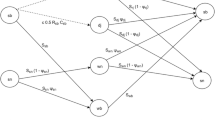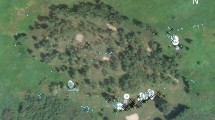Summary
The patterns of spatial heterogeneity in density and demography were studied in a population of Peromyscus leucopus inhabiting a deciduous forest in west-central Indiana. A series of 9 live-trapping grids sampled densities from 3 spatial scales: 3 ha, 80 ha and 350 km2. We found high levels of variation within all three spatial scales. There was as much variation within a single, large grid as within the entire Sugar Creek Valley (350 km2). The patterns of density variation were not temporally stable and thus represent variation in demographic processes rather than simply differences in habitat quality. We suggest that the Sugar Creek Valley represents a metapopulation of Peromyscus leucopus composed of a number of temporally unstable subpopulations. This structure provides considerable demographic variation that dispersing animals can exploit.
Similar content being viewed by others
References
Adler GH (1987) Influence of habitat structure on demography of two rodent species in eastern Massachusetts. Can J Zool 65:903–912
Anderson PK (1980) Evolutionary implications of microtine behavioral systems on the ecological stage. The Biologist 62:70–88
Batzli GO (1977) Population dynamics of the white-footed mouse in flood-plain and upland forest. Am Midl Nat 97:18–32
Bekoff M (1977) Mammalian dispersal and the ontogeny of individual behavioral phenotypes. Am Nat 111:715–732
Bowen BS (1982) Temporal dynamics of microgeographic structure of genetic variation in Microtus californicus. J Mammal 63:625–638
Cockburn A, Lidicker WZ Jr (1983) Microhabitat heterogeneity and population ecology of an herbivorous rodent, Microtus californicus. Oecologia 59:167–177
Garrett MG (1982) Demographic differences between an old and new colony of black-tailed prairie dogs. Am Nat 108:51–59
Gill DE (1978) The metapopulation ecology of the red-spotted newt, Notophthalmus viridescens (Rafinesque). Ecol Monogr 48:145–166
Hayne DW (1949) Calculation of size of home range. J Mammal 30:1–18
Krebs CJ (1966) Demographic changes in fluctuating populations of Microtus californicus. Ecol Monogr 36:239–273
Krebs CJ (1985) Ecology: the experimental analysis of distribution and abundance. 3rd ed. Harper and Row, NY
Krohne DT (1982) The demography of low litter size populations of Microtus californicus. Can J Zool 60:368–374
Krohne DT, Baccus R (1985) Genetic and ecological structure of a population of Peromyscus leucopus. J Mammal 6:529–537
Krohne DT, Miner MS (1985) Removal trapping studies of dispersal in Peromyscus leucopus. Can J Zool 63:71–75
Krohne DT, Baccus R, Dubbs BA (1984) An analysis of dispersal in an unmanipulated population of Peromyscus leucopus. Am Midl Nat 112:146–156
Lidicker WZ Jr (1975) The role of dispersal in the demography of small mammals. In: Golley FB, Petrusewicz K, Ryskowski L (eds). Small Mammals: Their Productivity and Population Dynamics. Cambridge University Press, Cambridge, pp 103–128
Lidicker WZ Jr (1978) Regulation of numbers in small mammal populations- historical reflections and a synthesis. In: Snyder DP (ed) Populations of Small Mammals Under Natural Conditions. Spec. Publ. Ser. No. 5, Pymatuning Lab Ecol., University of Pittsburgh. pp 122–166
Lidicker WZ Jr (1988) Solving the enigma of microtine “cycles”. J Mammal 69:225–235
Morisita M (1959) Measuring the dispersion of individuals and analysis of the distributional patterns. Mem Faculty Sci Kuyushu Univ Ser E 2:213–235
Morris DW (1987) Ecological scale and habitat use. Ecology 68:362–370
Patton JL, Feder J (1981) Microspatial heterogeneity in pocket gophers: non-random breeding and drift. Evolution 35:912–920
Roff DA (1974) The analysis of a population model demonstrating the importance of dispersal in a heterogeneous environment. Oecologia 15:259–275
Smith MH, Manlove MN, Joule J (1978) Genetic organization in space and time. In: Snyder DP (ed) Populations of Small Mammals Under Natural conditions. Spec. Publ. Pymatuning Lab of Ecology No. 5, University of Pittsburgh, pp 99–111
Sokal RR, Rohlf FJ (1969) Biometry, 1st edition, W.H. Freeman, San Francisco
West SD (1979) Dynamics of colonization and abundance in central Alaskan populations of the northern red-backed vole, C. rutilus. J Mammal 63:128–143
Wiens JA (1976) Population responses to patchy environments. Ann Rev Ecol Syst 7:81–120
Wiens JA (1980) Concluding comments: are bird communities real? Acta XVII Congressus Int. Ornith., Berlin, pp 1088–1089
Wiens JA, Rottenberry JT (1980) Bird community structure in cold shrub deserts: competition or chaos? Acta XVII Congressus Int. Ornith., Berlin, pp 1063–1070
Wolff JO, Lundy KI, Baccus R (1988) Dispersal, inbreeding avoidance and reproductive success in white-footed mice. Anim Behav 36:456–465
Author information
Authors and Affiliations
Rights and permissions
About this article
Cite this article
Krohne, D.T., Burgin, A.B. The scale of demographic heterogeneity in a population of Peromyscus leucopus . Oecologia 82, 97–101 (1990). https://doi.org/10.1007/BF00318539
Received:
Accepted:
Issue Date:
DOI: https://doi.org/10.1007/BF00318539




